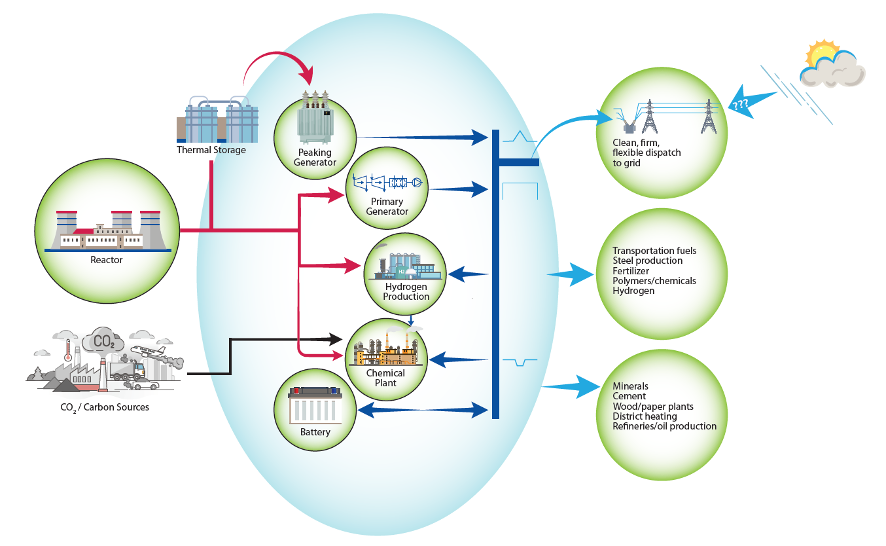System Operations
Research institutions, nuclear technology developers and vendors, and utilities have expressed interest in transforming how nuclear energy is used to meet our ever-growing energy demands. Traditionally, nuclear energy has been used to generate electricity—currently providing more than half of the non-emitting electricity in the U.S. The role of nuclear energy, however, is evolving. Nuclear energy utilization can be further enhanced by optimizing energy use through novel systems integration and process design—leveraging this highly reliable, dispatchable, and non-emitting energy source.
The primary output from a nuclear fission reactor is heat. Using this heat to produce nonelectrical energy services and products in addition to converting that heat to electricity for the grid provides new opportunities to decarbonize the traditionally “hard to abate" industrial and transportation sectors. These "integrated" or "hybrid" applications overcome the technical, economic, and institutional barriers that currently inhibit the wider use of nuclear energy in both centralized and distributed energy systems. The rapid build-out of renewable technologies and the availability of low-cost natural gas has created economic challenges to traditional generation systems. Variable renewable generators also introduce increasing variability in net electricity demand that must be met by traditional dispatchable generation. The demonstration of flexible nuclear energy use to support variable net grid demand and conversion of nuclear-generated energy into nonelectrical energy intermediates and products (e.g., gases, minerals, refined metals, chemicals/chemical feedstocks, freshwater) is a key focus of Integrated Energy Systems research and development.
 Integrated energy systems encompass both coordinated and tightly coupled energy system designs. In a coordinated energy system, multiple energy generators may interact within a grid balancing area, involving loosely coupled electrical, thermal, and chemical networks, as well as various scales of energy storage, provide reliable, sustainable, and affordable energy to a variety of energy users. A tightly coupled energy system involves co-design and co-control of multiple energy generators and energy users that are directly integrated via thermal, electrical, chemical means, which may include various forms of energy storage, working together to provide the lowest cost electricity to the grid while also supporting the production of other commodities.
Integrated energy systems encompass both coordinated and tightly coupled energy system designs. In a coordinated energy system, multiple energy generators may interact within a grid balancing area, involving loosely coupled electrical, thermal, and chemical networks, as well as various scales of energy storage, provide reliable, sustainable, and affordable energy to a variety of energy users. A tightly coupled energy system involves co-design and co-control of multiple energy generators and energy users that are directly integrated via thermal, electrical, chemical means, which may include various forms of energy storage, working together to provide the lowest cost electricity to the grid while also supporting the production of other commodities.
The DOE national laboratories, led by Idaho National Laboratory (INL), have been evaluating IES for a number of years via the DOE Office of Nuclear Energy Integrated Energy Systems Program (formerly Nuclear-Renewable Hybrid Energy Systems). INL researchers, in partnership with researchers at Argonne National Laboratory (ANL) and Oak Ridge National Laboratory (ORNL), have developed and continue to enhance a suite of analysis tools to optimize the design and operation of candidate IES configurations – see System Simulation for more information and related reports. The lab has also developed nonnuclear, electrically heated test and demonstration facilities to support IES development and demonstration. These facilities are summarized in Experimental Systems, with significant system testing being conducted in 2021, and new systems coming online to further enhance demonstration capabilities in 2022 and 2023.
As advanced reactor technologies come into the marketplace (e.g., high-temperature reactors), even more opportunities will arise for integrating these innovative energy systems into new or existing industrial infrastructure. The IES program activities have been coordinated with DOE's Energy Efficiency and Renewable Energy (EERE) Hydrogen and Fuel Cell Technologies Office (HFTO) since ~2014, with formal cost-share activities since 2018. Additional collaboration with DOE's Office of Fossil Energy (FE) was initiated in 2019. Demonstration activities related to the current fleet of light water reactors are managed by the DOE-NE LWRS Program Flexible Plant Operations & Generation Pathway. In 2021, the IES program additionally partnered with the National Reactor Innovation Center (NRIC) to begin the design of an advanced reactor IES testbed for future demonstrations (see the April 2021 NRIC Integrated Energy Systems Demonstration Pre-Conceptual Designs report for further information).
The evolution of the electrical grid, and a domestic and global trend to enhance adoption of clean, non-emitting energy generation and use across all energy sectors, will require more coordination of multiple energy generation sources across traditionally independent energy use sectors.
The Future of Energy: Integrated Hybrid Systems

